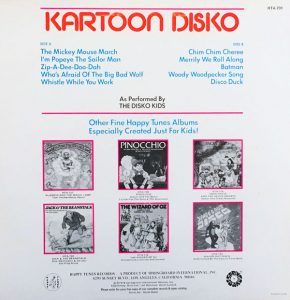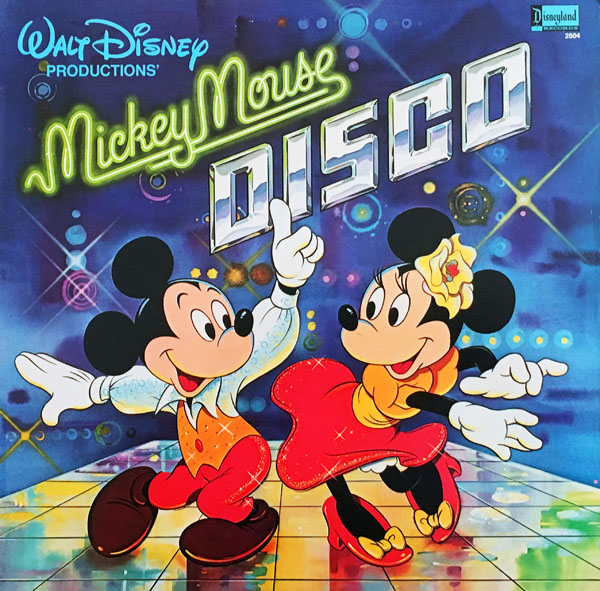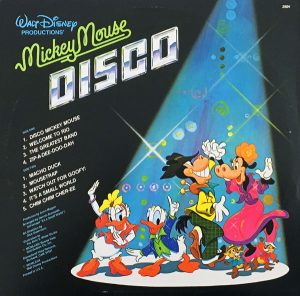In the late seventies, you never knew who was going to boogie next—Beethoven or Ethel Merman—so it was a matter of time before classic animated characters got into the beat.

KARTOON DISKO
Happy Tunes Records (Springboard International) HTA-731 (12” 33 1/3 RPM LP / Stereo)
Also released as “Cartoon Disco” on Musicor Records MUS-6501
Released in 1978. Engineer: Steve Lisi. Art Direction: David Lartaud. Cover Illustration: David Gantz. Running Time: 26 minutes.
Songs: “The Mickey Mouse March” by Jimmie Dodd; “I’m Popeye the Sailor Man” by Sammy Lerner; “Zip-A-Dee-Doo-Dah” by Allie Wrubel, Ray Gilbert; “Who’s Afraid of the Big Bad Wolf?” by Frank Churchill; Whistle While You Work” by Frank Churchill, Larry Morey; “Chim Chim Cheree” by Richard M. Sherman, Robert B. Sherman; “Merrily We Roll Along” by Eddie Cantor, Charles Tobias, Murray Menscher; “Batman” Theme by Neal Hefti; “Woody Woodpecker Song” by George Tibbles, Ramsey Idress; “Disco Duck” by Rick Dees.
 Pop culture loves a good trend, and disco was one of the most fervent crazes of the mid to late 1970s. Its basic form–combining a steady, pulsating rhythm with either strings or synth with a melody of any kind—eventually led artists and producers to discover that almost any piece of music could be retrofitted and given new life. Suddenly what was old became new again. It wasn’t long before there were multiple volumes of Hooked on Classics and Hooked on Big Bands. In addition, the release of a new blockbuster movie was also accompanied by a disco version of its theme, as was the case for Star Wars and Close Encounters of the Third Kind, both very successful for producer Meco Monardo, who also set the entire score of The Wizard of Oz to a disco beat.
Pop culture loves a good trend, and disco was one of the most fervent crazes of the mid to late 1970s. Its basic form–combining a steady, pulsating rhythm with either strings or synth with a melody of any kind—eventually led artists and producers to discover that almost any piece of music could be retrofitted and given new life. Suddenly what was old became new again. It wasn’t long before there were multiple volumes of Hooked on Classics and Hooked on Big Bands. In addition, the release of a new blockbuster movie was also accompanied by a disco version of its theme, as was the case for Star Wars and Close Encounters of the Third Kind, both very successful for producer Meco Monardo, who also set the entire score of The Wizard of Oz to a disco beat.
Independent record companies benefitted from disco because it was possible to sell records with the songs alone. It didn’t always matter if the disco version didn’t have the original artists because the disco version wasn’t such a different interpretation, though Perry Como and Percy Faith did create new renditions of their classic hits. But when cartoon fans picked up their LP of Kartoon Disko at Woolworth’s, W.T. Grant or S.S. Kresge, they may have expected Mel Blanc or Jack Mercer to be singing or to hear soundtracks because that wasn’t usually the disco style.
The same album was marketed to two audiences. Kartoon Disko was released as a children’s album by Springboard International on their “Happy Tunes” label, and it was also released the same year by Musicor Records as Cartoon Disco, with two young adults dancing in Mickey Mouse-ear shirts on the cover. Since both labels specialized in reissues from numerous locations and catalogs, the source of the productions themselves could be Canada or Europe.
Nashville may also have been the source of the music, as most of Disneyland’s Mickey Mouse Disco was recorded there. Interestingly, two tracks on Kartoon Disko, “Zip-A-Dee-Doo-Dah” and “Chim Chim Cheree,” appeared on Mickey Mouse Disco LP a year later.

Walt Disney Productions’
MICKEY MOUSE DISCO
Disneyland Records #2504 (12” 33 1/3 RPM LP / Stereo)
Picture Disc Reissue #3111 (1982)
CD Reissue #60353-7 (1995)
40th Anniversary “Vinyl Vault” LP Reissue D-003010601 (Record Store Day 2019)
Released in July, 1979. Producer: Jymn Magon. Art Direction: Dick Duerrstein. Cover Illustration: Alvin S. White Studio. Running Time: 30 minutes.
Original Songs: “Disco Mickey Mouse,” “Macho Duck” by Tom Worrall; “Welcome to Rio,” “Watch Out for Goofy!” by George Charouhas, Steven Bruce Furman; “The Greatest Band” by Pat Patrick; “Mousetrap” by Jymn Magon.
Disney Classics: “Zip-A-Dee-Doo-Dah” by Allie Wrubel, Ray Gilbert; “It’s a Small World,” “Chim Chim Cheree” by Richard M. Sherman, Robert B. Sherman.
Mickey Mouse Disco did not mark the first time the Disney record company tried to boogie on the disco highway. Two years earlier, when the second iteration of the Mickey Mouse Club appeared, several musical numbers caught the disco beat, including the revamped theme song and a song called “Discovery Day”, which ended with the new Mouseketeers singing “D-I-S-C-O day!” Several of these songs appeared on the soundtrack album.
A few weeks later, a new Mouseketeers single was released featuring Jimmie Dodd’s “Mickey Mouse March” retitled “Disco Mouse.” The record was promoted on the daytime show several times, including a segment in which Disneyland-Vista’s manufacturing plant was shown pressing the 45 RPM singles. However, “Disco Mouse” did not light up the charts in any significant way.
It all changed in 1979. Though the disco craze was on the wane and a disco record destruction event was staged in Chicago, several factors made Mickey Mouse Disco a major influence in children’s records and the Disney label itself. One was the use of the characters, which were surprisingly dormant at the time. Mickey and his friends very rarely made appearances on TV in any new form, and while there were still theme park greetings and scattered merchandise, there had been no records with the gang for years.
 Wunkerkind Producer Jymn Magon and Disneyland-Vista President Gary Krisel recognized the public affection for Mickey and the gang. “We were amazed how little was being done with the characters back then,” Magon recalled. “To us it made perfect sense to make records with them and to find new ways to bring them to audiences.”
Wunkerkind Producer Jymn Magon and Disneyland-Vista President Gary Krisel recognized the public affection for Mickey and the gang. “We were amazed how little was being done with the characters back then,” Magon recalled. “To us it made perfect sense to make records with them and to find new ways to bring them to audiences.”
Disco may have cooled off as a hip trend, but it was actually mainstream by this time to be made “cute.” It would not be the first time an iconic figure was seen in the familiar John Travolta pose from Saturday Night Fever, but the cover of Mickey Mouse Disco was imitated as far as other children’s record producers were concerned. Sesame Street Fever, also a huge success, is one example, and Peter Pan Records created a best-selling line of albums featuring their own character, Irwin the Disco Duck, which was also inspired by Rick Dees’ novelty hit “Disco Duck,” a song that used a Donald Duck-like voice.
Among Magon’s tasks was to arrive at musical concepts to suit all the characters. “To me it was like story editing a TV script,” Magon told me and Ed Robertson of radio’s TV Confidential, “You try to invest the writers with an idea of what would work, so I felt that I was sort of story editing that album as opposed to producing it. It was very easy to see Donald as a very macho duck.”
Which led to another success factor. “Macho Duck” and “Watch Out for Goofy” lent themselves well to visuals, and to television. For the second time in Disneyland Records history (the first being the innovation of direct mail album offers created by label founder Jimmy Johnson), Mickey Mouse Disco was sold on through direct response advertising. This time however, the album was sold on TV in an “exclusive” direct response offer that also included Volumes One and Two of the Disney’s Children’s Favorites LP series. The TV spot made use of classic Disney shorts, timed to fit the tracks on the album. The sales were astronomical. Eventually, Mickey Mouse Disco became the first children’s record in history to go double-platinum (selling two million copies).
In 1980, the same technique was used for a theatrical Mickey Mouse Disco featurette with footage from Thru The Mirror, The Three Caballeros, Clock Cleaners, Mr. Duck Steps Out, How to Dance, Mickey’s Delayed Date and Mickey’s Birthday Party. Jymn Magon’s own composition, “Mousetrap”, served as the main title music. This film was first released on a double bill with the live-action feature The Last Flight of Noah’s Ark then enjoyed regular play on Disney’s various cable outlets.
The response to Mickey Mouse Disco proved there was an audience for character-based productions with inventive twists, and it revitalized the Disney record label in a way that no other release had in over a decade. Part of its appeal was that it was not so much a dance album as it was made for listening as well. It told stories in song through original and classic tunes with a strong replay factor that somehow clicks, whether one is generally a fan or foe of disco.
Last May, the two industry icons came together when Walt Disney Records Producer Randy Thornton presented Disneyland-Vista Records Producer with the 40th Anniversary Record Store Day Edition of Mickey Mouse Disco at a Disneyana Fan Club event celebrating Disney records.
“Welcome to Rio”
José Carioca is finally celebrated in song in this exuberant confection by longtime Disneyland Records engineer George Charouhas and Steven Bruce Furman. Like the ‘40s Latin pop classic “Brazil,” which was introduced to the U.S. in The Three Caballeros and was made into a disco song in 1975, “Welcome to Rio” seems to perfectly blend the each era of music, as well as Disney lore.


 GREG EHRBAR is a freelance writer/producer for television, advertising, books, theme parks and stage. Greg has worked on content for such studios as Disney, Warner and Universal, with some of Hollywood’s biggest stars. His numerous books include Mouse Tracks: The Story of Walt Disney Records (with Tim Hollis). Visit
GREG EHRBAR is a freelance writer/producer for television, advertising, books, theme parks and stage. Greg has worked on content for such studios as Disney, Warner and Universal, with some of Hollywood’s biggest stars. His numerous books include Mouse Tracks: The Story of Walt Disney Records (with Tim Hollis). Visit 






















































The “New Mickey Mouse Club”‘s Wednesday’s theme song was “Surprise Day” (not any version of Discovery).
Thursday was Discovery Day, but with a different song by Al Kasha & Joel Hirschhorn (entitled Let’s Discover Discovery Day)
The Song “D-I-S-C-O-very Day” you mentioned was featured on Episode 16 as a “Mousekatalent” segment only.
It was not a regular feature.
As you correctly stated, “Disco Mouse” song was introduced in Episode 71 (which included the pressing of the record).
Effective from the 16th week of all new episodes, the opening songs for Monday – Thursday were dropped, in place of a varying abbreviated version of “Disco Mouse”, sung over New Mouseketeer clips from this group of episodes.
Friday (Showtime) still retained its original song for the duration of the series.
John Tracy, who had for the most part only directed the Friday segments in the first batch, now directed most of the episodes of the 2nd batch.
Other disco segments included on the show (as Mousekatalent segments) included the song “Mousekadance Disco” and “Disc To Disco” (an all dance piece showing the evolution of dance from rag to disco)
Wow, that’s impressive info! Thanks very much for all the detail. I had forgotten that the daily theme songs had eventually become replaced except for Disco Mouse and the Friday song.
We will amend the paragraph to change my errors identifying “Discovery Day” as the song that played for Discovery Day, when it was actually “Let’s Discover Discovery Day” and it was actually on Thursdays.
Thank you for taking the time to share your knowledge of a show that is largely forgotten but was a lovely little oasis of Disney magic every day for many of us during a time when there was no cable, no video and very little animation on TV during the week.
What would a montage that covered everything since the death of disco include?
I should also have added that the song “D-I-S-C-O-very day” was also included in “Happy Birthday Donald Duck” (1976), which aired on “The Wonderful World Of Disney” prior to “The New Mickey Mouse Club” premiering.
“At Home With Donald Duck” (1956), which incorporated “MIckey Mouse Club” footage aired on the Disneyland TV show during “The Mickey Mouse Club” run.
“Happy Birthday Donald Duck” was “At Home With Donald Duck” retitled and with “New Mickey Mouse Club” footage substituting for the original Club footage.
Thank you Greg for your response.
“The New Mickey Mouse Club”‘s best moment was the cartoon (and finally putting titles to cartoons I had seen on the Sunday night show many times, but never knew their names e.g. “Lucky Number” (1951) and “Winter Storage” (1949)) and the animated film clips “Scenes from a Mousekamovie”.
However the mouseketeer segments were always well done (despite a couple of them who plainly couldn’t sing), presenting themselves as likeable, and not precocious or Shirley Temple wannabes.
Background music for the show not only featured instrumental versions of Disney songs from the animated movies. They also featured themes from live action Disney movies such as “Toby Tyler” (1960), “Monkees Go Home (1966)”, “The Boatniks” (1970), “Snowball Express” (1972) and “The Mystery Of The Whiz Kid At Riverton” (1974).
In addition a number of good songs were written especially for the show including “Country Flavor”, “Have You Ever Thought About A Flower?”, “It’s Nice To Be Alone”, “Jillion Dollar John/Jill”, “Taco & A Burger”, “Where The Wind Blows” and “You’re Really Terrific”
(And yes, I do have the “Mickey Mouse Disco” record)
Still have mom’s original album of Disco Mickey Mouse from when she taught. Such a collectors’ item
I found the picture disc of Mickey Mouse disco. I treasure Horace in his pimped-out threads.
It was nice to see him wear something besides his usual collar!
Apparently, culture also loves a soul-sucking bad trend as well = disco.
Ah well, any opportunity for golden age toons to show up and be seen isn’t a bad thing. I guess.
Love the blatantly bad Popeye caricature in the album art.
Japan did get a fun single out of it though!
https://www.youtube.com/watch?v=UcA7nXqK3CA
God, I had that Mickey Mouse Disco record. I hated it.
Love the “Mickey Mouse Disco” album! My favorite track is “Watch Out for Goofy.”
I also have the “Cartoon Disco” album, both as the Musicor LP version and the digital “Saturday Morning Fever” reissue on iTunes. Their take on “Who’s Afraid of the Big Bad Wolf” is fun!
Great stuff but, man, those ‘Cartoon Disko’ cuts.
I kept waiting for them to morph into a blistering dance jam…but that never happened.
Reminds me of an LP i have called ‘Pink Panther Punk’ (maybe you’ve covered it). It’s oddly enjoyable, but about as far from “punk” as you could imagine. It’s great! 🙂
Yes, we covered the very strange Pink Panther records here:
https://cartoonresearch.com/index.php/the-pink-panther-on-records-sort-of/
A unique read. This form of trend is certainly not common and it makes me wonder why.
“Brazil” was used in Saludos Amigos
Part of “Zip-A-Dee-Do-Dah” from MMD was sampled on Fatboy Slim’s immortal “Praise You”
Correction: “It’s a Small World”
“Disco Mickey Mouse” was also part of the Walt Disney Records Archive Collection Vol.1